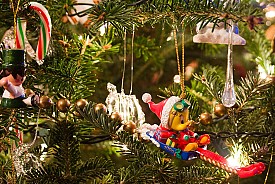Your Holiday Electrical Safety Guide
 The lights are ablaze this holiday season, but you definitely don't want your house alight along with them, because that is a sure way to ruin the holidays. Instead, follow some basic safety tips from Networx and organizations like the Electrical Safety Foundation International to keep the season bright, cheerful, and safe for everyone, including kids, pets, and your drapes!
The lights are ablaze this holiday season, but you definitely don't want your house alight along with them, because that is a sure way to ruin the holidays. Instead, follow some basic safety tips from Networx and organizations like the Electrical Safety Foundation International to keep the season bright, cheerful, and safe for everyone, including kids, pets, and your drapes!
Purchase safety-rated electrical items, consider longer-lasting and cooler LEDs instead of incandescents, and don't use items that aren't designed as holiday lighting if they might pose a safety issue. If you have some heirloom electrical decorations like lights from the fifties, now is a good time to think about giving them an honorable retirement.
Manage your electrical cords
It's tempting to lay out cords wherever you see a path, but resist. If that path is frequently used by people and pets, the cord could present a tripping hazard. And if a problem develops, someone could be in for a nasty shock. Instead, tuck cords away and tape or clip them in place to make sure they don't wander.
Turn it off
Heading out for the night? Going to bed? Turn your holiday displays off, so that they don't have a chance to develop a problem and run wild while you're gone. If you're worried about the apperance of an empty house, follow some of our holiday security tips to keep your home unappealing to those who might want to pop in to play Scrooge while you're gone.
Don't use frayed, cracked, or otherwise obviously damaged cords
That includes lighting strings, extension cords, and anything else. Buy replacements or have them repaired by a skilled electrician, because they are a safety hazard.
Don't overload your cords
Check the load rating, and confirm that a cord can handle what's plugged into it. If it can't, you need a cord with a higher rating, or you run the risk of damaging anything plugged into it, as well as starting an electrical fire. Generally, no more than three strands of lights can be plugged into each other.
...or your outlets and circuits
Make sure you know which outlets are on which circuit, and don't overload them, either! Your house should have an electrical diagram making note of which outlets and other receptacles are attached to which circuit, and if it doesn't, well, now's a fine time to make one. Think ahead, too: house guests probably want outlets for charging devices, using laptops, and running hair dryers, so make sure they won't overload a circuit either.
Don't pinch!
Make sure extension cords and lighting strands aren't pinched in furniture, doorjambs, or anywhere else. It can damage the insulation and fray the wiring inside, which is dangerous.
These specialized circuits (also required in bathrooms and kitchens) cut out when weather conditions like rain and snow create a hazard. You need them for any outdoor lighting displays...and all the cords, strands, and similar supplies you install outdoors should be rated for outdoor use.
Secure outdoor lighting well
Wind can bluster and rain can fall, but your lights shouldn't be going anywhere. You don't want lighting to pull loose, where it could start a fire, snag, tangle, or create a tripping hazard. And don't even think about nailing or pinning those wires in place, because that could damage the insulation. Use appropriate clips and hardware.
Keep out of reach of pets and children
If you have family members with curious hands, paws, or mouths, take extra care to keep electrical cords, strands, and decorations well out of reach. Split loom tubing is ideal for covering cords to make it hard to bite them, and you can also firmly tape down hidden cords to make them hard to access. Make sure young family members know that it's not safe to play with the lighting, and that they should come get you if they notice anything unusual.
Keep away from heat
Electrical cords, trees, and decor should be kept at least three feet away from any heat sources. Even at that distance, it's advisable to periodically check to make sure nothing is getting too hot. If you aren't sure about safe clearances, ask your New York HVAC technician for advice.
Katie Marks writes for Networx.com.
Looking for a Pro? Call us (866) 441-6648

Electrical Average Costs
Electricians Experiences

Look To Your Electrician For Advice On The Best Lighting System

Hardworking Handyman Brings Christmas To Southern California



